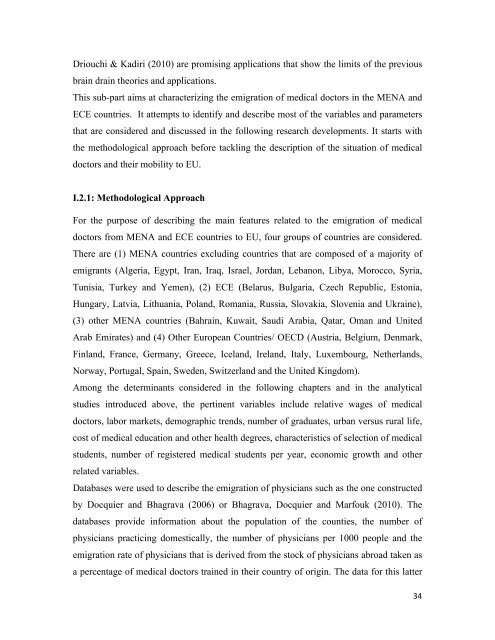Download the report - Femise
Download the report - Femise
Download the report - Femise
You also want an ePaper? Increase the reach of your titles
YUMPU automatically turns print PDFs into web optimized ePapers that Google loves.
Driouchi & Kadiri (2010) are promising applications that show <strong>the</strong> limits of <strong>the</strong> previous<br />
brain drain <strong>the</strong>ories and applications.<br />
This sub-part aims at characterizing <strong>the</strong> emigration of medical doctors in <strong>the</strong> MENA and<br />
ECE countries. It attempts to identify and describe most of <strong>the</strong> variables and parameters<br />
that are considered and discussed in <strong>the</strong> following research developments. It starts with<br />
<strong>the</strong> methodological approach before tackling <strong>the</strong> description of <strong>the</strong> situation of medical<br />
doctors and <strong>the</strong>ir mobility to EU.<br />
I.2.1: Methodological Approach<br />
For <strong>the</strong> purpose of describing <strong>the</strong> main features related to <strong>the</strong> emigration of medical<br />
doctors from MENA and ECE countries to EU, four groups of countries are considered.<br />
There are (1) MENA countries excluding countries that are composed of a majority of<br />
emigrants (Algeria, Egypt, Iran, Iraq, Israel, Jordan, Lebanon, Libya, Morocco, Syria,<br />
Tunisia, Turkey and Yemen), (2) ECE (Belarus, Bulgaria, Czech Republic, Estonia,<br />
Hungary, Latvia, Lithuania, Poland, Romania, Russia, Slovakia, Slovenia and Ukraine),<br />
(3) o<strong>the</strong>r MENA countries (Bahrain, Kuwait, Saudi Arabia, Qatar, Oman and United<br />
Arab Emirates) and (4) O<strong>the</strong>r European Countries/ OECD (Austria, Belgium, Denmark,<br />
Finland, France, Germany, Greece, Iceland, Ireland, Italy, Luxembourg, Ne<strong>the</strong>rlands,<br />
Norway, Portugal, Spain, Sweden, Switzerland and <strong>the</strong> United Kingdom).<br />
Among <strong>the</strong> determinants considered in <strong>the</strong> following chapters and in <strong>the</strong> analytical<br />
studies introduced above, <strong>the</strong> pertinent variables include relative wages of medical<br />
doctors, labor markets, demographic trends, number of graduates, urban versus rural life,<br />
cost of medical education and o<strong>the</strong>r health degrees, characteristics of selection of medical<br />
students, number of registered medical students per year, economic growth and o<strong>the</strong>r<br />
related variables.<br />
Databases were used to describe <strong>the</strong> emigration of physicians such as <strong>the</strong> one constructed<br />
by Docquier and Bhagrava (2006) or Bhagrava, Docquier and Marfouk (2010). The<br />
databases provide information about <strong>the</strong> population of <strong>the</strong> counties, <strong>the</strong> number of<br />
physicians practicing domestically, <strong>the</strong> number of physicians per 1000 people and <strong>the</strong><br />
emigration rate of physicians that is derived from <strong>the</strong> stock of physicians abroad taken as<br />
a percentage of medical doctors trained in <strong>the</strong>ir country of origin. The data for this latter<br />
! #$!
















